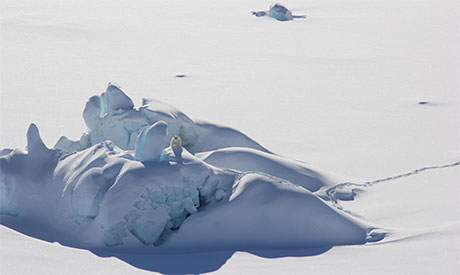
A lone polar bear on top of a snow covered iceberg in The Wandel Sea of Greenland on July 1, 2021. AFP
Strong wind and warming led to record low ice cover in the Arctic's "Last Ice Area" last year, according to research published Thursday that suggests the frozen refuge for polar bears is more vulnerable to climate change than thought.
The Wandel Sea, a part of the Arctic Ocean north of Greenland, is typically covered with thick, multi-year layers of ice.
While the overall extent of summer sea ice in the Arctic has been declining rapidly over several decades, the Last Ice Area had been expected to stay frozen for far longer than other regions even as temperatures climb.
But in August 2020, scientists measured a record low of just 50 percent sea ice concentration in the Wandel Sea.
To find out why, researchers based in the US and Europe looked at satellite data and sea ice models, which account for environmental conditions such as wind and temperature.
They found that 80 percent of the ice loss was attributable to unusually strong winds, which broke up and blew away much of the ice.
Examining simulations for the area based on data dating back to 1979, the team estimated that climate change had caused the other 20 percent of melt.
Authors said their research, published in the journal Communications Earth and Environment, showed that the Last Ice Area was more vulnerable to future melt events than previously assumed.
"The future of Arctic winds is kind of hard to predict, but warming is pretty certain and will lead to further thinning of the ice everywhere in the Arctic," co-author Michael Steele from the University of Washington told AFP.
"The big surprise of our research is that ice loss is happening in this 'Last Ice Area' so soon. We expected that ice would last longer."
- Last refuge-
Arctic summer sea ice extent has decreased nearly three quarters in just 40 years as temperatures at the top of the world rise much faster than elsewhere.
As a result, species that use the sea ice to hunt for food and raise their young -- most notably polar bears -- are in precipitous decline.
The Last Ice Area has long been viewed as a place for the bears that would persist for decades even as other ice vanishes in summer.
"Current thinking is that this area may be the last refuge for ice-dependant species," said lead author Axel Schweiger, a polar scientist at the University of Washington's Applied Physics Laboratory.
"So if, as our study shows, it may be more vulnerable to climate change than people have been assuming, that's important."
Short link: